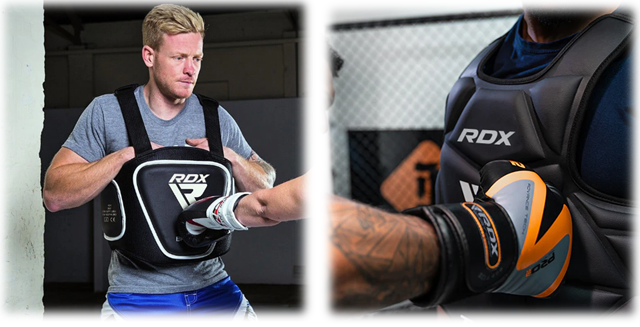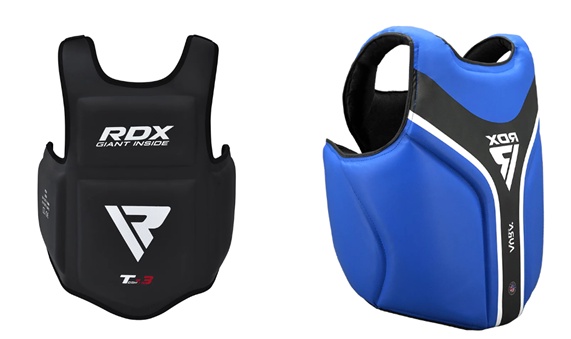In the realm of sports and other physically demanding activities, safety equipment plays a pivotal role in preventing injuries. Among these protective gears, chest guard stand as crucial armour, safeguarding athletes and workers alike from potential harm. Let's delve into the world of chest guards, exploring their significance, types, materials, and more.
Importance of Chest Guards in Sports:
Chest guards serve as a vital shield against impact and force, particularly in contact sports such as cricket, baseball, hockey, and martial arts. By absorbing and dispersing energy, they reduce the risk of serious injuries like rib fractures, contusions, and even cardiac trauma. Additionally, in non-sporting environments like construction sites or industrial settings, chest guards offer essential protection against workplace hazards.
Types of Chest Guards:
Traditional Chest Guards:
Traditionally, chest guard were bulky and rigid, primarily constructed from materials like hard plastic or metal. While effective in providing protection, they often compromised mobility and comfort.
Modern Chest Guards:
With advancements in technology and materials, modern chest guards offer a balance between protection and flexibility. They feature lightweight yet durable materials such as high-density foam, carbon fibber, or Kevlar, ensuring both safety and comfort for the wearer.
Materials Used in Chest Guards:
The choice of materials greatly influences the performance and comfort of chest guards. Foam padding provides cushioning and shock absorption, while carbon fibber and Kevlar offer superior strength and durability. Mesh fabrics enhance breathability, preventing overheating during prolonged use.
Factors to Consider When Choosing a Chest Guard:
When selecting a chest guard, several factors should be taken into account, including size, fit, flexibility, and intended use. A properly fitting chest guard should cover the vital areas without restricting movement or causing discomfort.
Proper Fit and Sizing of Chest Guards:
Ensuring the right fit is essential for maximizing protection and comfort. Chest guard come in various sizes, typically ranging from small to extra-large, with adjustable straps for a customized fit. It's crucial to follow manufacturer guidelines for sizing and adjustment to ensure optimal performance.
Maintenance and Care of Chest Guards:
- Regular Cleaning:
- Clean the chest guard regularly using mild soap and water.
- Gently scrub any dirt or debris, paying attention to crevices and padding.
- Avoid Extreme Conditions:
- Store chest guard in a cool, dry place away from direct sunlight.
- Avoid exposure to extreme temperatures, which can degrade materials over time.
- Inspect for Wear and Damage:
- Routinely inspect the chest guard for any signs of wear, tear, or damage.
- Check for loose stitching, cracks, or dents that may compromise protection.
- Follow Manufacturer Guidelines:
- Adhere to manufacturer recommendations for maintenance and care.
- Follow specific instructions for cleaning, drying, and storing the chest guard.
- Air Dry Properly:
- After cleaning, allow the chest guard to air dry thoroughly before storage.
- Avoid using heat sources such as dryers, as they may damage the materials.
- Disinfection:
- If necessary, use disinfectant sprays or wipes to sanitize the chest guard.
- Ensure the disinfectant is compatible with the materials used in the chest guard
- Avoid Harsh Chemicals:
- Refrain from using harsh chemicals or solvents, as they may degrade the materials.
- Stick to mild soap and water for cleaning to preserve the integrity of the chest guard.
- Maintain Straps and Fasteners:
- Check the straps and fasteners regularly for any signs of damage or wear.
- Replace worn-out straps or fasteners to ensure a secure fit and optimal protection.
- Store Properly:
- Store the chest guard in a ventilated area to prevent moisture build-up.
- Avoid folding or crushing the chest guard, as this may deform the shape and compromise protection.
- Replace When Necessary:
- Replace the chest guards if it shows signs of significant wear, damage, or deterioration.
- Follow manufacturer guidelines for the lifespan of the chest guard and replace accordingly.
Advancements in Chest Guard Technology:
Advancements in Chest Guard Technology have revolutionized the way athletes and workers are protected from impact-related injuries. These technological innovations focus on enhancing both the protective capabilities and the comfort of chest guards, ensuring optimal performance in various environments.
Furthermore, advancements in ergonomic design have led to chest guards that conform more closely to the body's contours, providing a snug and secure fit. Adjustable straps and customizable features allow users to tailor the chest guard to their specific needs, ensuring maximum comfort and protection during prolonged wear.
Incorporation of moisture-wicking fabrics and ventilation channels is another notable advancement in chest guard technology. These features help regulate body temperature and manage sweat build-up, keeping athletes cool and dry even during intense physical activity. Improved breathability not only enhances comfort but also reduces the risk of skin irritation and chafing.
Additionally, advancements in manufacturing processes have enabled the production of chest guards with seamless construction and minimal seams. This streamlined design not only improves aesthetics but also reduces the likelihood of chafing and irritation, particularly during prolonged wear.

Chest Guards in Different Sports:
Cricket:
In cricket, chest guards, also known as "abdominal guards" or "box guards," are worn by batsmen and wicketkeepers to protect against fast-paced deliveries and accidental impacts.
Baseball:
Baseball catchers rely on chest protectors to shield themselves from foul balls, wild pitches, and collisions at home plate. These chest guards feature additional padding in key areas for maximum protection.
Hockey:
Hockey players wear chest guards under their jerseys to mitigate the risk of injuries from high-speed puck impacts, collisions with other players, and falls onto the ice.
Martial Arts:
In martial arts disciplines like taekwondo and karate, chest guards are mandatory equipment, providing protection during sparring sessions and tournaments.
Chest Guards for Safety in Work Environments:
Beyond the realm of sports, chest guards find applications in various industries where workers are exposed to potential hazards. Construction workers, for instance, wear chest guards to protect against falling debris, sharp objects, and other workplace dangers.
Conclusion:
Chest guards are indispensable safety equipment that transcends the boundaries of sports, offering protection and peace of mind to athletes, workers, and individuals engaged in physically demanding activities. With advancements in design and technology, these essential gears continue to evolve, ensuring optimal performance and comfort for users.


No comments yet